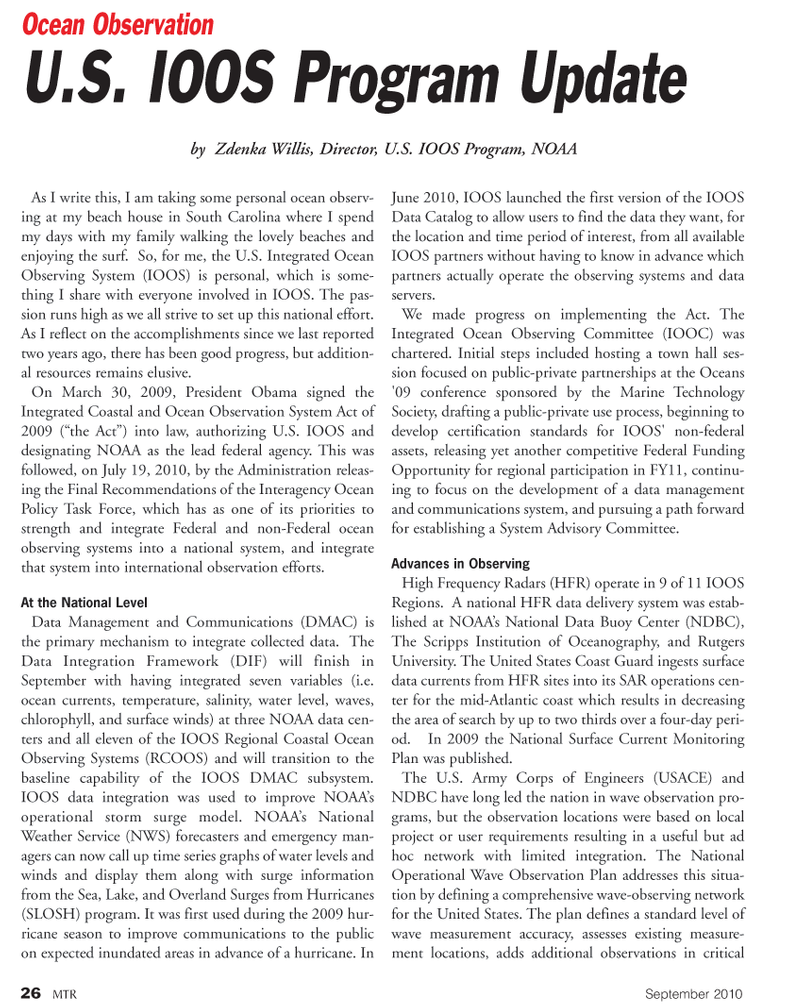
Page 26: of Marine Technology Magazine (September 2010)
Ocean Observation
Read this page in Pdf, Flash or Html5 edition of September 2010 Marine Technology Magazine
As I write this, I am taking some personal ocean observ- ing at my beach house in South Carolina where I spend my days with my family walking the lovely beaches and enjoying the surf. So, for me, the U.S. Integrated Ocean
Observing System (IOOS) is personal, which is some- thing I share with everyone involved in IOOS. The pas- sion runs high as we all strive to set up this national effort.
As I reflect on the accomplishments since we last reported two years ago, there has been good progress, but addition- al resources remains elusive.
On March 30, 2009, President Obama signed the
Integrated Coastal and Ocean Observation System Act of 2009 (“the Act”) into law, authorizing U.S. IOOS and designating NOAA as the lead federal agency. This was followed, on July 19, 2010, by the Administration releas- ing the Final Recommendations of the Interagency Ocean
Policy Task Force, which has as one of its priorities to strength and integrate Federal and non-Federal ocean observing systems into a national system, and integrate that system into international observation efforts.
At the National Level
Data Management and Communications (DMAC) is the primary mechanism to integrate collected data. The
Data Integration Framework (DIF) will finish in
September with having integrated seven variables (i.e. ocean currents, temperature, salinity, water level, waves, chlorophyll, and surface winds) at three NOAA data cen- ters and all eleven of the IOOS Regional Coastal Ocean
Observing Systems (RCOOS) and will transition to the baseline capability of the IOOS DMAC subsystem.
IOOS data integration was used to improve NOAA’s operational storm surge model. NOAA’s National
Weather Service (NWS) forecasters and emergency man- agers can now call up time series graphs of water levels and winds and display them along with surge information from the Sea, Lake, and Overland Surges from Hurricanes (SLOSH) program. It was first used during the 2009 hur- ricane season to improve communications to the public on expected inundated areas in advance of a hurricane. In
June 2010, IOOS launched the first version of the IOOS
Data Catalog to allow users to find the data they want, for the location and time period of interest, from all available
IOOS partners without having to know in advance which partners actually operate the observing systems and data servers.
We made progress on implementing the Act. The
Integrated Ocean Observing Committee (IOOC) was chartered. Initial steps included hosting a town hall ses- sion focused on public-private partnerships at the Oceans '09 conference sponsored by the Marine Technology
Society, drafting a public-private use process, beginning to develop certification standards for IOOS' non-federal assets, releasing yet another competitive Federal Funding
Opportunity for regional participation in FY11, continu- ing to focus on the development of a data management and communications system, and pursuing a path forward for establishing a System Advisory Committee.
Advances in Observing
High Frequency Radars (HFR) operate in 9 of 11 IOOS
Regions. A national HFR data delivery system was estab- lished at NOAA’s National Data Buoy Center (NDBC),
The Scripps Institution of Oceanography, and Rutgers
University. The United States Coast Guard ingests surface data currents from HFR sites into its SAR operations cen- ter for the mid-Atlantic coast which results in decreasing the area of search by up to two thirds over a four-day peri- od. In 2009 the National Surface Current Monitoring
Plan was published.
The U.S. Army Corps of Engineers (USACE) and
NDBC have long led the nation in wave observation pro- grams, but the observation locations were based on local project or user requirements resulting in a useful but ad hoc network with limited integration. The National
Operational Wave Observation Plan addresses this situa- tion by defining a comprehensive wave-observing network for the United States. The plan defines a standard level of wave measurement accuracy, assesses existing measure- ment locations, adds additional observations in critical 26 MTR September 2010
Ocean Observation
U.S. IOOS Program Update by Zdenka Willis, Director, U.S. IOOS Program, NOAA

 25
25

 27
27
